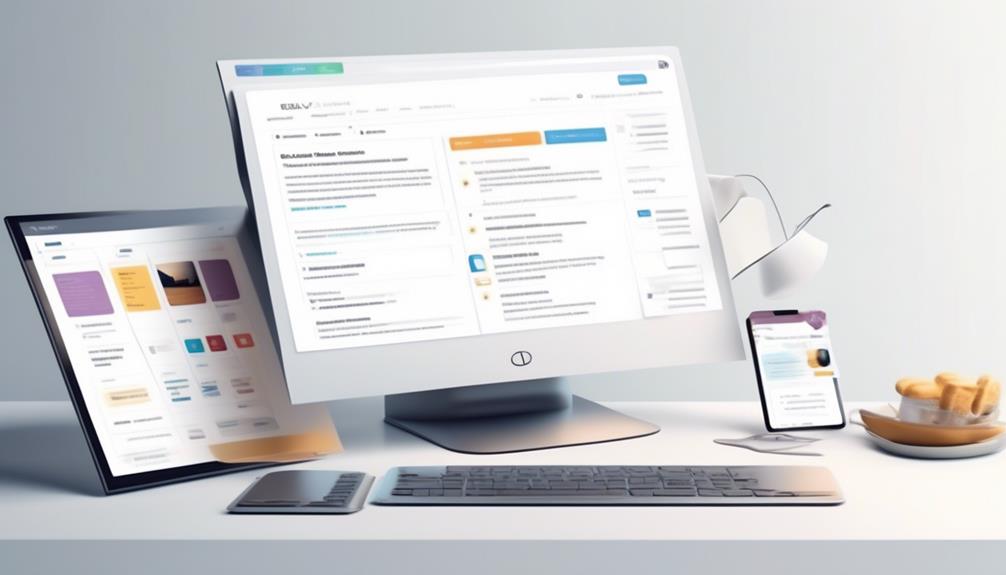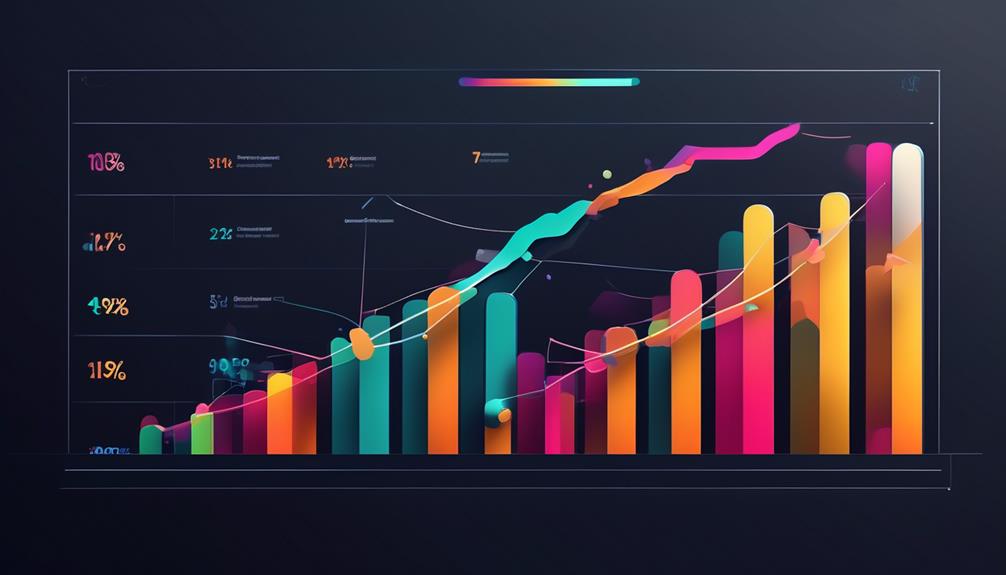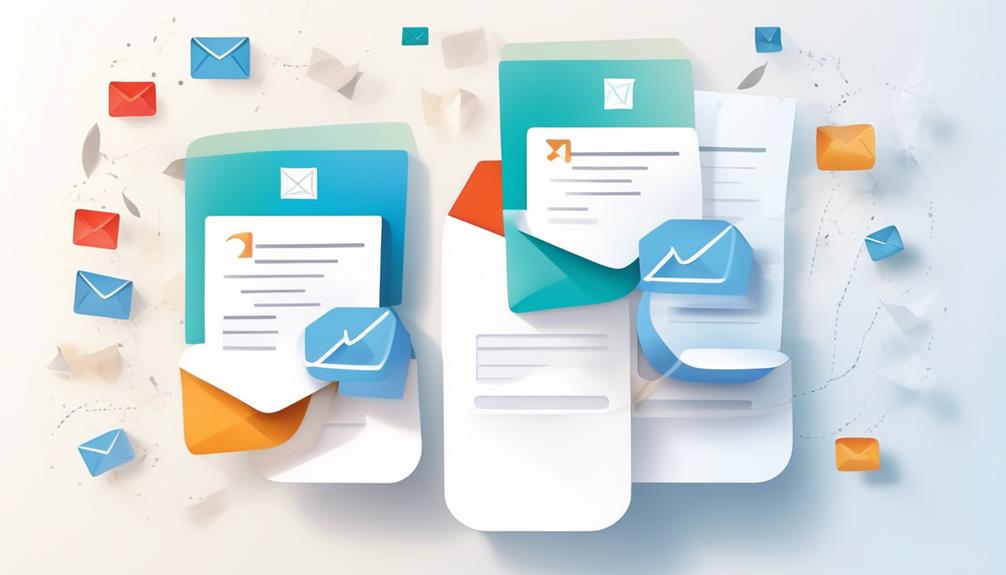Imagine your email marketing strategy as a well-crafted puzzle, with each piece fitting perfectly to create a mesmerizing picture.
Personalized email marketing is like the glue that holds those pieces together, making the entire puzzle come to life.
So, how do you ensure that your emails stand out in a crowded inbox and resonate with your audience? Well, let's just say it involves a dash of creativity, a sprinkle of data, and a whole lot of strategic finesse.
Stick around to uncover the expert tips that will take your personalized email marketing game to the next level.
Key Takeaways
- Understanding your audience and segmenting your email list is crucial for effective personalized email marketing. By analyzing customer data and creating different audience segments based on characteristics, you can tailor email content to specific groups, show that you care about their preferences, and create highly targeted campaigns.
- Personalized content delivery and using dynamic content within emails can significantly increase engagement and conversions. By breaking down your email list into specific segments and tailoring content based on demographics, behavior, or preferences, you can send targeted messages like product recommendations, event invitations, or special promotions. Additionally, using dynamic content allows you to insert or change specific elements based on subscribers' preferences, behavior, or demographics, further personalizing your emails.
- Personalizing subject lines by including the recipient's name or relevant details can significantly increase the open rate of your emails. By showing that you understand the recipient's interests and can provide tailored recommendations, you can capture their attention and encourage them to open your emails.
- Utilizing geolocation targeting, optimizing send times, and testing personalization tokens are effective strategies for personalized email marketing. By delivering content based on subscribers' location, sending emails at optimal times based on their time zone, and experimenting with different personalization tokens, you can boost engagement, response rates, and open rates. Additionally, monitoring and analyzing results, leveraging A/B testing, and continuously improving your strategies based on feedback and analytics tools are essential for successful personalized email marketing.
Understand Your Audience
To create personalized email marketing that resonates with your audience, you need to truly understand their wants, needs, and preferences. It's like being a mind reader, but with data! Start by digging into your customer data to uncover insights about their behavior and interests. Look at past purchases, website interactions, and survey responses. This will help you paint a vivid picture of who your audience is and what they're looking for.
Once you have a good grasp of your audience, it's time to segment them into different groups based on their characteristics. This will allow you to tailor your email content to specific segments, making it more relevant and engaging for each group. For example, you might've one segment for loyal customers who frequently purchase, and another for potential customers who've shown interest but haven't made a purchase yet.
Understanding your audience is the key to unlocking the power of personalized email marketing. By using data to create targeted content, you can show your audience that you know and care about what they want. And that's the kind of innovation that will set your email marketing apart from the rest.
Segment Your Email List
Hey there!
Want to make your email marketing more effective? It's all about segmenting your email list.
By targeting specific recipient groups, you can deliver personalized content that resonates with each individual.
This approach can lead to higher engagement and better results for your email campaigns.
Targeted Recipient Groups
Segmenting your email list allows you to target specific recipient groups with personalized content tailored to their interests and needs. By dividing your subscribers into segments based on demographics, behavior, or preferences, you can create highly targeted and relevant email campaigns.
For example, you could segment your list by age, location, purchase history, or engagement level. This targeted approach enables you to send more personalized and valuable content, increasing the likelihood of engagement and conversions.
Additionally, you can use dynamic content within your emails to further customize the message for each segment. By understanding your recipients' unique needs and preferences, you can deliver innovative and impactful email marketing campaigns that resonate with each specific group.
Personalized Content Delivery
Consider how you can break down your email list into specific segments based on demographics, behavior, or preferences to deliver personalized content that resonates with each group's interests and needs.
By segmenting your email list, you can tailor your content to different audience segments, making your emails more relevant and engaging. For example, you can create segments based on past purchase behavior, geographic location, or engagement with your previous emails.
This allows you to send targeted content, such as product recommendations, event invitations, or special promotions, that are more likely to resonate with each segment. The more personalized your content delivery, the higher the chances of driving engagement and conversions.
Use Dynamic Content

Hey there! Ready to take your email marketing to the next level? Using dynamic content means you can tailor your message to each recipient, making your emails more relevant and engaging.
Plus, personalized product recommendations can boost your click-through rates and drive more sales.
Let's dive into how to make your emails stand out with dynamic content!
Tailored Message Content
Craft personalized email messages using dynamic content to engage your audience with relevant and tailored information.
Dynamic content allows you to create personalized messages by inserting or changing specific elements based on your subscribers' preferences, behavior, or demographics.
By using dynamic content, you can deliver targeted messages that resonate with your audience, making your emails more effective and engaging.
Whether it's showcasing products based on past purchases, recommending content based on their interests, or addressing them by their first name, dynamic content helps you create a more personalized and meaningful experience for your subscribers.
This level of personalization not only increases engagement but also drives higher conversion rates.
Embracing dynamic content in your email marketing strategy demonstrates your commitment to delivering innovative and tailored experiences to your audience.
Personalized Product Recommendations
When tailoring your email marketing, leverage dynamic content to provide personalized product recommendations that resonate with your audience's preferences and behaviors. Dynamic content allows you to showcase products tailored to each subscriber's interests, browsing history, and past purchases.
By analyzing customer data, such as their previous interactions with your brand and their preferences, you can create hyper-personalized product recommendations that feel like a friendly suggestion rather than a generic promotion. Imagine the impact of receiving an email with product recommendations perfectly suited to your taste! This level of personalization not only boosts engagement but also increases the likelihood of conversions.
Embrace the power of dynamic content to deliver innovative and personalized product recommendations that captivate your audience and drive results.
Personalize Subject Lines
To grab your reader's attention from the get-go, consider personalizing your subject lines with their name or relevant details. Personalized subject lines can significantly increase the open rate of your emails. People are more likely to open an email when they see their name in the subject line, or when the subject line reflects their interests or previous interactions with your brand.
One way to personalize subject lines is by using the recipient's name. For example, instead of a generic subject line like 'Check Out Our Latest Offers,' you could use 'Sarah, Exclusive Offers Just for You!' This simple tweak adds a personal touch and shows that you value the recipient as an individual.
Another approach is to use relevant details based on the recipient's behavior or preferences. For instance, if a customer has previously purchased running shoes from your store, you could send an email with the subject line 'Gear Up for Your Next Run, Emily!' This demonstrates that you understand the recipient's interests and can provide tailored recommendations.
Leverage Behavioral Data

Hey there! Ready to take your email marketing to the next level?
Let's talk about leveraging behavioral data to create targeted content and tailored messaging strategies.
Targeted Content Creation
Leveraging behavioral data allows you to create targeted content that resonates with your audience's interests and preferences. By understanding your audience's behavior, such as their browsing history, purchase patterns, and email engagement, you can tailor your content to their specific needs and desires.
Imagine sending out an email featuring products or services that your audience has previously shown interest in – it's like offering them exactly what they want before they even realize they want it! This level of personalization not only captures their attention but also increases the likelihood of conversion.
With the power of behavioral data at your fingertips, you can craft emails that feel like they were made just for each recipient, making your marketing efforts more impactful and your audience more engaged.
Tailored Messaging Strategies
Crafting tailored messaging strategies that leverage behavioral data allows you to connect with your audience on a deeper level. By analyzing your audience's behavior, such as their website visits, purchase history, or email engagement, you can send personalized messages that resonate with their actions.
For instance, if a customer frequently browses a certain product category on your website, you can send them targeted emails featuring similar products or exclusive offers in that category. Leveraging behavioral data empowers you to anticipate your audience's needs and deliver content that truly speaks to them.
This not only enhances customer satisfaction but also increases the likelihood of conversion, making your email marketing efforts more effective and relevant.
Incorporate User Preferences
To enhance your personalized email marketing, consider tailoring the content based on your subscribers' individual preferences and interests. Incorporating user preferences into your email marketing strategy can significantly boost engagement and conversion rates.
Start by gathering data on your subscribers' behavior, such as their browsing history, purchase patterns, and interaction with your previous emails. Use this information to create segmented lists and deliver content that aligns with each group's specific interests.
For example, if a subscriber has shown a preference for a particular product category, you can send them personalized recommendations or exclusive offers related to that category.
Another way to incorporate user preferences is by allowing subscribers to choose the type and frequency of emails they receive. Provide options for subscribers to indicate their preferences, such as receiving weekly newsletters, product updates, or promotional offers.
Implement A/B Testing

Discover how A/B testing can help you optimize your email marketing strategy to better resonate with your audience and drive improved results. A/B testing allows you to experiment with different elements of your emails, such as subject lines, calls to action, or images, to see which version performs better. It's like being a mad scientist in a lab, testing different concoctions to see which one creates the most powerful reaction.
By conducting A/B tests, you can gain valuable insights into what really grabs your audience's attention and prompts them to take action. This data-driven approach empowers you to make informed decisions about your email content, layout, and design. It's like having a secret weapon that helps you tailor your emails to perfection.
Imagine being able to send out emails that you know will resonate with your audience. A/B testing makes this a reality by allowing you to fine-tune your emails based on real feedback. It's like having a crystal ball that shows you exactly what your audience wants, so you can deliver it to them every time.
Utilize Geolocation Targeting
Want to engage your audience on a more personal level? Try utilizing geolocation targeting in your email marketing strategy. Geolocation targeting allows you to deliver personalized content based on your subscribers' location. By segmenting your email list according to geographical location, you can tailor your content to include location-specific offers, events, or even weather-related promotions.
For example, if you have a retail store with multiple locations, you can send targeted emails promoting in-store events or special offers based on the recipient's proximity to each store. This level of personalization shows your subscribers that you understand their local context and increases the relevance of your emails.
Beyond just promoting offers, geolocation targeting can also be used to create a sense of community by highlighting local events or news relevant to your subscribers. By showing that you're tuned in to what's happening in their area, you can build a stronger connection with your audience.
Additionally, using geolocation data to send emails at the optimal times based on the recipient's time zone can improve engagement and conversion rates. Embracing geolocation targeting in your email marketing not only demonstrates your commitment to personalization but also shows that you're on the cutting edge of innovative marketing strategies.
Optimize Send Times

You can boost engagement and response rates by optimizing the timing of your email sends. Think about it like this: would you want to receive an email about a hot new product at 3 a.m.? Probably not. That's why finding the right send time is crucial.
Start by analyzing your audience's behavior. Are they night owls or early birds? Once you have that figured out, try scheduling your emails to hit their inboxes during peak open times. It's like serving a delicious meal when you know your guests are the hungriest.
Another cool trick is to experiment with different send times. Maybe Mondays at 8 a.m. work best for your audience, or perhaps they're more responsive on Thursday afternoons. Don't be afraid to test and tweak until you find that sweet spot.
And hey, why not try sending emails at odd hours just for fun? Sometimes, catching people off guard can lead to higher open rates. So, grab your data, put on your detective hat, and start sleuthing for the perfect send time. Your audience will thank you for it!
Integrate Social Media Data
After nailing down the ideal send times for your emails, you can take things up a notch by integrating social media data into your personalized email marketing strategy. This can help you further tailor your messages to your audience's preferences and behaviors, making your emails even more engaging and effective.
To integrate social media data effectively, consider the following:
- Understand Audience Interests: Use social media analytics to gain insights into what topics and content types resonate most with your audience. This can help you craft email content that aligns with their interests.
- Analyze Engagement Patterns: Look into the types of posts or content that receive the most engagement on social media. This can give you valuable clues about what kind of content your audience finds most compelling.
- Leverage User-generated Content: Incorporate user-generated content from social media into your emails. This can add authenticity and relevance to your messages, strengthening the connection with your audience.
Craft Compelling Content

Crafting compelling content for your personalized email marketing campaigns can significantly enhance engagement and drive action from your audience. The key is to create content that resonates with your subscribers and provides value. Start by understanding your audience's pain points, interests, and preferences. Use this insight to tailor your content to their needs and aspirations.
Experiment with different types of content, such as storytelling, educational content, or user-generated content, to keep your emails fresh and engaging.
Incorporate personalized elements into your content, such as using the recipient's name, referencing their past purchases or interactions with your brand, and recommending products or services based on their preferences. This level of personalization can make your emails feel more relevant and tailored to each recipient, increasing the likelihood of them taking action.
Additionally, leverage dynamic content that adapts based on the recipient's behavior or demographics. This can include showcasing different products based on their browsing history or location, or customizing the email layout to match their device preferences.
Ultimately, the goal is to create content that captivates your audience, drives interaction, and encourages them to take the next step in their customer journey. By continuously testing and optimizing your content based on performance metrics, you can fine-tune your approach and deliver even more compelling emails.
Test Personalization Tokens
As you experiment with different types of content for your personalized email marketing, it's time to put your personalized elements to the test and see how they resonate with your audience through 'Test Personalization Tokens'.
When it comes to testing personalization tokens in your email marketing, here are a couple of strategies to consider:
- A/B Testing: Try out different personalization tokens in your email subject lines and see which ones lead to higher open rates. For example, test using the recipient's first name versus their full name to see which one grabs their attention more.
- Dynamic Content Testing: Experiment with personalized content within the body of your emails. Test different product recommendations, personalized offers, or customized images to see which ones drive more engagement and conversions.
Monitor and Analyze Results
Once you have sent out your personalized emails, it's important to actively monitor and analyze the results to understand the impact of your personalization efforts on your audience. Keep an eye on open rates, click-through rates, and conversion rates to gauge the effectiveness of your personalized email campaigns. Look for patterns in the data to see which personalization strategies are resonating with your audience and which ones may need tweaking.
Utilize A/B testing to compare different personalization approaches and see which ones yield better results. This can help you fine-tune your strategies and optimize future email campaigns. Pay attention to the feedback you receive from your audience as well; their responses can provide valuable insights into the effectiveness of your personalization efforts.
Leverage analytics tools to gain deeper insights into your audience's behavior and preferences. By understanding how recipients are engaging with your personalized emails, you can continuously improve your strategies and provide even more relevant content.
Frequently Asked Questions
How Can I Ensure That My Personalized Email Marketing Efforts Align With My Overall Brand Messaging and Values?
To ensure your personalized email marketing aligns with your brand messaging and values, meticulously map out your message. Maintain a mindful mindset, making meaningful connections with your audience. Match your mission to maximize marketing impact.
What Are Some Effective Strategies for Re-Engaging Inactive Subscribers Through Personalized Email Campaigns?
To re-engage inactive subscribers, try creating personalized email campaigns that offer exclusive content or discounts, ask for feedback, or remind them of the value of your brand. Make it feel like they're missing out on something special.
How Can I Effectively Measure the ROI of My Personalized Email Marketing Efforts?
To effectively measure the ROI of your personalized email marketing efforts, start by tracking key metrics like open rates, click-through rates, and conversion rates. Use tools like Google Analytics or your email service provider's built-in analytics for detailed insights.
What Are Some Best Practices for Ensuring That My Personalized Email Campaigns Are Gdpr-Compliant?
Just like a careful gardener tending to their plants, ensure your personalized email campaigns are GDPR-compliant by obtaining clear consent, providing opt-out options, and safeguarding data. Your audience's trust is key!
What Are Some Common Pitfalls to Avoid When Implementing Personalized Email Marketing Strategies, and How Can I Mitigate These Risks?
When implementing personalized email marketing, avoid generic content, over-segmentation, and neglecting data privacy. Mitigate these risks by creating valuable, relevant content, segmenting strategically, and respecting privacy regulations to build trust and engagement.